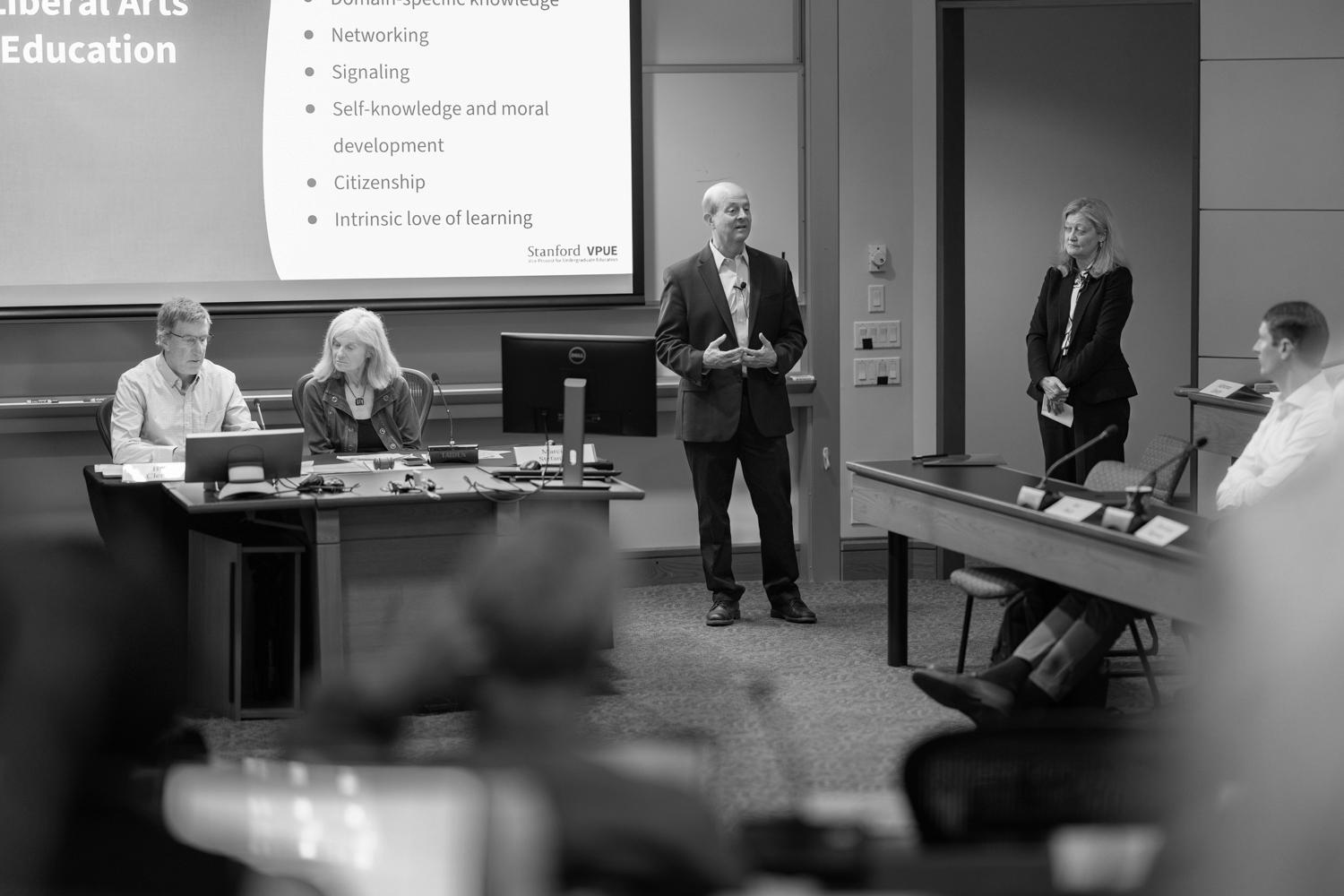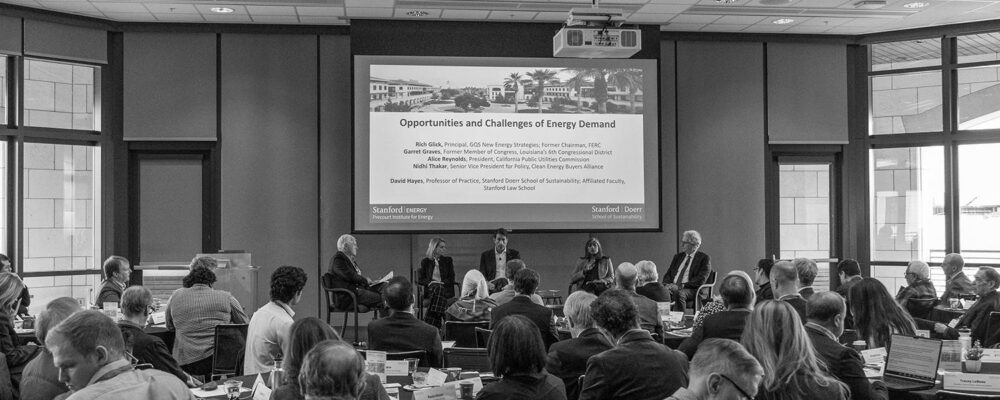The Faculty Senate received updates Thursday from the vice provosts of undergraduate education and student affairs regarding their efforts to support and enhance the Stanford undergraduate experience. Senators also learned about the Emeriti/ae Council’s work addressing the needs of the university’s emeriti community.
Stanford strives to offer undergraduates a modern liberal arts education focused on self-knowledge, moral development, citizenship, and an intrinsic love of learning, said Jay Hamilton, the Freeman-Thornton Vice Provost for Undergraduate Education (VPUE).
“Our students are curious,” Hamilton said. “They’re open – and by open I mean open to new ideas, to new experiences, to other people. That’s captured in the ePluribus initiative. They’re really optimistic about their ability to change themselves and the world.”
The university is fortunate to have not only its seven schools but also the Hoover Institution, Hamilton said, which adds ideological diversity.
VPUE programs include the first-year Civic, Liberal, and Global Education (COLLEGE) requirement, the Program in Writing and Rhetoric, and co-curricular experiences such as the Bing Overseas Studies Program and the Haas Center for Public Service. The Center for Teaching and Learning (CTL) also serves as a catalyst for innovation in undergraduate education, Hamilton said.
Hamilton discussed his own experience teaching a COLLEGE course, during which Jay Bhattacharya, professor emeritus of health policy, who was recently appointed director of the National Institutes of Health, was included on his class reading list. Hamilton said that students engaged critically and respectfully with each other during discussion of the text.
Current VPUE priorities include the Leveling the Learning Landscape (L3) initiative and the second phase of the Study of Writing at Stanford, a multi-year examination of Stanford’s efforts to enhance undergraduates’ writing skills and competencies. The office is also considering expanding the COLLEGE program and reaffirming the academic compact – a shared commitment among students, staff, and instructors to a common set of values, norms, expectations, and policies in their educational activities and learning communities.
Hamilton noted that some faculty have struggled to get students to uphold their side of the compact post-pandemic. “I’m hoping that we will be able to generate a conversation about what students and faculty can expect from each other,” he said.
Uncertainty about generative AI is a concern shared by faculty and students, Hamilton said. To address this, VPUE’s AImES (AI Meets Education at Stanford), coordinated by CTL, is holding a campus-wide discussion on generative AI in Stanford teaching and learning. AImES plans to provide faculty with guidance and assignment resources and advice by midsummer.
Student affairs
Vice Provost for Student Affairs Michele Rasmussen said her office (VPSA) is focused on empowering students to shape their Stanford experience and fostering a culture that encourages both strategic risk-taking and help-seeking.
“Ideally, students should, as quickly as possible, become their own best advocates for themselves and for their interests and be able to readily access services and resources that will help them pursue those interests,” Rasmussen said.
VPSA is developing a vision for undergraduate residential life that preserves Stanford’s signature strengths and cherished traditions, increases faculty involvement, and improves resource stewardship, Rasmussen said.
Rasmussen also said VPSA is collaborating with the Office of Community Standards (OCS) and the Office of Accessible Education (OAE) to streamline how students receive disability accommodations and help reinforce the academic compact.
Some senators expressed concerns about how the university can support disability accommodations in light of an ongoing pilot of proctoring. Rasmussen said the OAE is working to align decisions on who receives accommodations with what’s required under the Americans with Disabilities Act and encouraged faculty to contact OAE directly.
Several senators and student senate representatives raised concerns about the planned sunset of two co-op houses, Synergy and Terra. Rasmussen said the decision was driven by low pre-assignment numbers, but added that she would meet with student leaders to discuss housing rankings and priorities.
“By no means is the decision an indictment on the quality and importance of the co-ops, which we understand are very beloved and valued on this campus,” Rasmussen said.
Emeriti engagement
Stanford’s talented emeriti community remains active in numerous ways, and they seek more community, intellectual stimulation, and purpose, Emeriti/ae Council Chair Iris Litt said.
The council’s survey data show many emeriti face loneliness and feelings of alienation, said Litt, the Marron and Mary Elizabeth Kendrick Professor in Pediatrics, Emerita.
“It’s time to recognize that our emeriti are living 30 to 40 years longer than [when the professoriate was created],” Litt said. “Not only that … they want to be able to continue their intellectual life and to give back to the university.”
With a three-year grant from the provost and former president Richard Saller, the council is working to improve communications with emeriti, expand intellectual programming and community engagement, and establish an emeriti center.
In the 2024-25 academic year, the council hosted a Q&A with Stanford President Jonathan Levin, extended its partnership with the Stanford Faculty Club, launched a new website, and hosted roundtable lunches on topics like AI in medicine. It also continues to offer two lecture series: the David B. Abernethy Autobiographical Reflections Series, and the Longevity Series, covering topics such as sleep and aging, Alzheimer’s, and coping with loss.
Gavin Jones, the Frederick P. Rehmus Family Professor in Humanities in the School of Humanities and Sciences (H&S) and professor of English, asked whether emeriti could help mentor associate professors, who he said “sometimes drop off the mentoring cliff.”
Litt welcomed the idea, adding that the “experience and context that people at this stage have can be very much valued and helpful to the associate professors as they seek promotion.”
President Levin acknowledged that being part of an intellectual community becomes a large part of a faculty member’s identity, and he thanked Litt and the Emeriti/ae Council for their efforts to support emeriti, noting that “all of us in this body will someday benefit from that.”
Leadership updates
Levin also discussed a recent article on research security threats from the Chinese Communist Party and reiterated Stanford’s ongoing commitment to both national security and research security, citing the university’s response.
“Stanford has been a leader for a number of years in researching and advancing best practices to address foreign influence in research, not only on campus but also across the nation, and that’s happened in a number of ways, including through efforts at the Hoover Institution,” Levin said. “We continue to engage in efforts around research security in the United States.”
Levin pointed to the Hoover Institution’s widely circulated 2019 report, China’s Influence and American Interests, and its 2020 report, Global Engagement: Rethinking Risk in the Research Enterprise. Hoover is also conducting a joint project with Texas A&M and the University of Washington, funded by the National Science Foundation (NSF), on safeguarding the U.S. research ecosystem.
In response to a question about international students and research security, Levin said attracting global talent and ensuring education for students worldwide at places like Stanford is key to U.S. leadership in science and technology.
“Part of the success of that strategy has been that we attract incredibly talented students, faculty as well, and we bring them here,” he said, adding that NSF data show many international students who complete U.S. graduate programs remain in the country and contribute meaningfully.
“Certainly it corresponds to the statistics we have at Stanford about our own students who come here to participate in the community, to learn, and then to go on to be productive contributors to both the country and the world,” Levin said.
Provost Jenny Martinez discussed a task force of faculty students and staff that was recently appointed to consider expanding the undergraduate class. The task force is co-chaired by Hamilton and Kathryn “Kam” Moler, the Marvin Chodorow Professor in the School of Humanities and Sciences, professor of applied physics, of physics, and of energy science and engineering.
“While our faculty, staff, postdocs, and graduate student populations have grown over several decades, the undergraduate population has remained relatively stable despite the fact that during the last 15 years or so, the number of applicants has increased dramatically,” Martinez said. Past efforts to explore expansion were stalled by events like the 2008-09 financial crisis and the COVID-19 pandemic.
The new task force will assess how to increase the undergraduate class while preserving Stanford’s educational quality and culture, Martinez said.
The senate’s Steering Committee also presented a resolution from the Associated Students of Stanford University on fossil fuel industry funding of research.
For more information
Hamilton is the Hearst Professor and a professor of communication in the School of Humanities and Sciences and a senior fellow at the Stanford Institute for Economic Policy Research. Moler is the vice president of the SLAC National Accelerator Laboratory.
“Stanford University, officially Leland Stanford Junior University, is a private research university in Stanford, California. The campus occupies 8,180 acres, among the largest in the United States, and enrols over 17,000 students.”
Please visit the firm link to site






